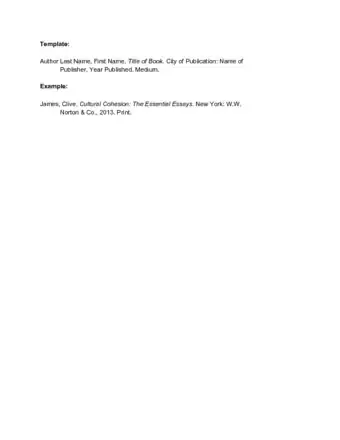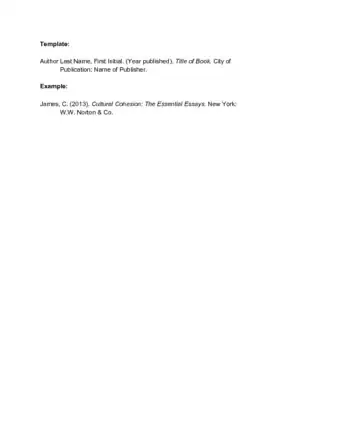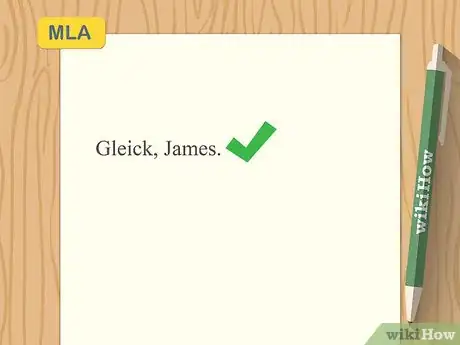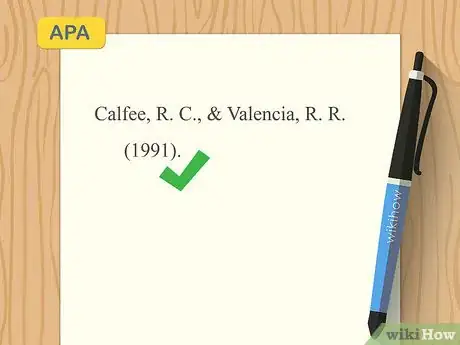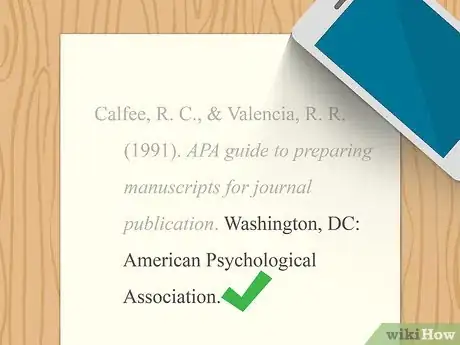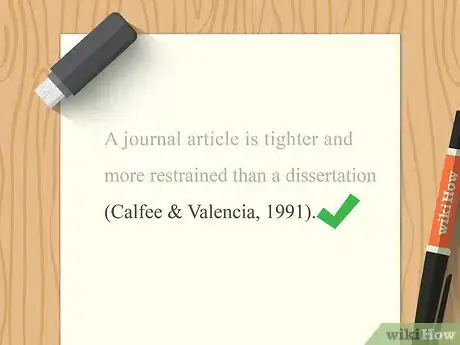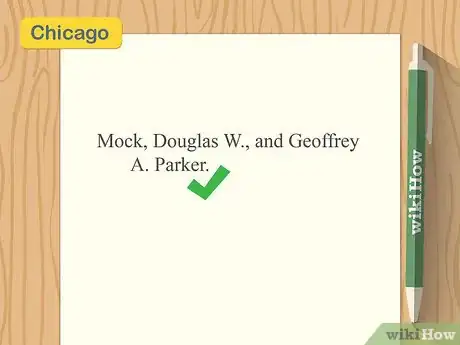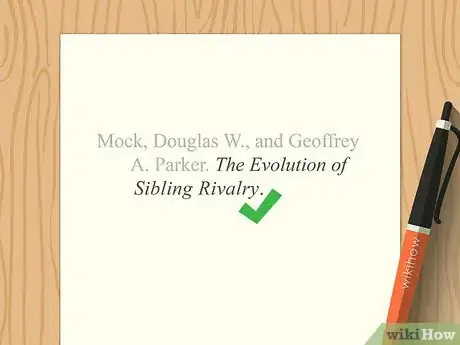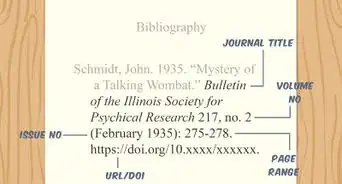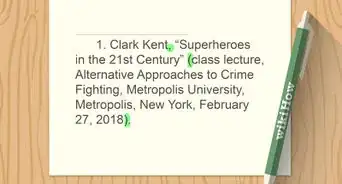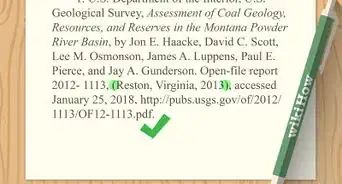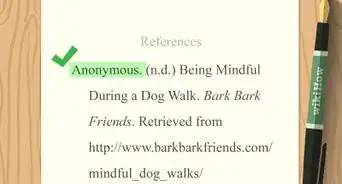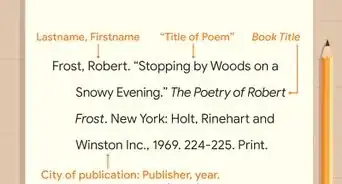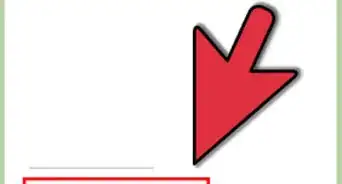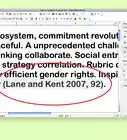This article was co-authored by wikiHow staff writer, Jennifer Mueller, JD. Jennifer Mueller is a wikiHow Content Creator. She specializes in reviewing, fact-checking, and evaluating wikiHow's content to ensure thoroughness and accuracy. Jennifer holds a JD from Indiana University Maurer School of Law in 2006.
There are 7 references cited in this article, which can be found at the bottom of the page.
This article has been viewed 177,274 times.
Learn more...
When you're writing a research paper, a citation lets your readers know which words or ideas are not your own. Generally, you'll place an in-text citation at the end of every sentence in which you've either paraphrased or quoted ideas or language from the source. That in-text citation points your reader to the full citation in the reference list at the end of your paper. While the basic information included in a citation for a book is the same, the format varies among the Modern Language Association (MLA), American Psychological Association (APA), and Chicago citation styles.
Steps
Citation Templates and Sample Citations
MLA
-
1Begin your Works Cited entry with the name of the author. Type the author's last name first, followed by a comma and a space. Then type the author's first name. If the author's middle name or middle initial are included on the title page for the book, include those as well. Place a period at the end of the author's name.[1]
- Example: Gleick, James.
- If the book has 2 or 3 authors, separate authors' names with commas, using the word "and" before the last author's name. Only the first author's name is inverted. For example: Gillespie, Paul and Neal Lerner.
- If the book has more than 3 authors, use the first author's name, followed by a comma and the Latin abbreviation "et. al." For example: Wysocki, Anne Frances, et. al.
-
2Provide the title of the book in italics. Type the title of the book using title case, capitalizing all nouns, pronouns, verbs, adverbs, and other words with more than 4 letters. If the book has a subtitle, type a colon and a space at the end of the title, then add the subtitle. Place a period at the end.[2]
- Example: Gleick, James. Chaos: Making a New Science.
Advertisement -
3Include the publisher and year of publication. Type the name of the publisher of the book, followed by a comma and a space. Then type the year the book was published. Place a period at the end of your citation.[3]
MLA Works Cited Format
Last Name, First Name. Title of Book in Title Case: Subtitle in Title Case. Publisher, Year.
-
4Use the author's name and page number for in-text citations. Whenever you paraphrase or quote from the book, place a parenthetical citation at the end of the sentence, inside the closing punctuation. Include the author's last name and the page number or page range where the material can be found.[5]
- For example, you might write: "While weather can be expressed in averages and statistics, the reality of nature is that nothing ever happens exactly the same way twice (Gleick 12)."
- If you use the author's name in the body of your paper, only include the page number or page range in your parenthetical citation.
APA
-
1List the author's name and date of publication. Start your Reference List entry with the author's last name, followed by a comma and a space. Then type the author's first initial (and middle initial, if given). Separate the names of multiple authors with commas, placing an ampersand (&) before the last author's name. Add the year of publication in parentheses. Place a period outside the closing parentheses.[6]
- Example: Calfee, R. C., & Valencia, R. R. (1991).
-
2Provide the title of the book in italics. Type the title of the book in sentence case, capitalizing only the first word and any proper nouns in the title. If the book has a subtitle, add it in sentence case after the title. Use a colon to separate the title and the subtitle. Place a period at the end.[7]
- Example: Calfee, R. C., & Valencia, R. R. (1991). APA guide to preparing manuscripts for journal publication.
- If you used an ebook, provide the ebook type in square brackets after the title. Do not italicize the bracketed information. Place the period outside the closing brackets rather than at the end of the title.[8] For example: Calfee, R. C., & Valencia, R. R. (1991). APA guide to preparing manuscripts for journal publication [Kindle ed.].
-
3Close with the location and name of the publisher. For US and Canadian publications, provide the name of the city and the 2-letter postal abbreviation for the city or state. For all other publications, list the name of the city and the name of the country. Type a colon and a space, then the name of the publisher. Place a period at the end of the name of the publisher.[9]
- Example: Calfee, R. C., & Valencia, R. R. (1991). APA guide to preparing manuscripts for journal publication. Washington, DC: American Psychological Association.
APA Reference List Format
Last Name, First Initial. Middle Initial. (Year). Title of book in sentence case: Subtitle in sentence case. Location: Publisher.
-
4Use the author's last name and date of publication for in-text citations. Whenever you paraphrase or quote material from your source, provide a parenthetical citation at the end of the sentence. List the author's last name, followed by a comma, then the year the book was published.[10]
- For example, you might write: "A journal article is tighter and more restrained than a dissertation (Calfee & Valencia, 1991)."
- If you include the author's name in the body of your paper, add a parenthetical immediately after the name with the year of publication.
- When you quote from the source directly, include the page number or page range where the quoted material can be found in your citation. Place a comma after the year of publication, then the abbreviation "p." or "pp." followed by the page number or range.
Chicago
-
1Provide the name of the author or authors. In your bibliography, type the author's last name first, followed by a comma and a space. Type the author's first name, followed by their middle name or initial, if given. For multiple authors, only reverse the order of the first author's name. Separate authors' names with commas, using the word "and" before the last author's name. Place a period at the end.[11]
- Example: Mock, Douglas W., and Geoffrey A. Parker.
-
2Add the title of the book in italics. Type the title of the book in title case, capitalizing only the first word, nouns, pronouns, verbs, and adverbs. If the book has a subtitle, place a colon at the end of the title to introduce the subtitle. Type the title of the subtitle in title case. End with a period.[12]
- Example: Mock, Douglas W., and Geoffrey A. Parker. The Evolution of Sibling Rivalry.
-
3Close with publication information. Type the place of publication, followed by a colon and a space. Type the name of the publisher, followed by a comma and a space. Then type the year the book was published. Place a period at the end of your bibliography entry.[13]
- Example: Mock, Douglas W., and Geoffrey A. Parker. The Evolution of Sibling Rivalry. Oxford: Oxford University Press, 1997.
- If you accessed an ebook rather than a print book, indicate the ebook edition at the end of the citation.[14] For example: Mock, Douglas W., and Geoffrey A. Parker. The Evolution of Sibling Rivalry. Oxford: Oxford University Press, 1997. Kindle edition.
Chicago Bibliography Format
Last Name, First Name. Title of Book in Title Case: Subtitle in Title Case. Location: Publisher, Year.
-
4Adjust your format when writing in-text footnotes. When you paraphrase or quote your source, place a superscript footnote number at the end of the sentence. The footnote includes the same information as the bibliography entry, formatted differently. Don't reverse any names, and use commas instead of periods to separate elements of the citation. Place the publication information in parentheses. Close your footnote with the page number or range where the paraphrased or quoted material can be found, followed by a period.[15]
- Example: Douglas W. Mock and Geoffrey A. Parker, The Evolution of Sibling Rivalry (Oxford: Oxford University Press, 1997), 72.
Community Q&A
-
QuestionWhat if I want to include 3 authors? For example, their names are Arden Blight, Clark Dirk, and Emelia Firth.
 Tom De BackerTop AnswererIf they are equal contributors, either list them alphabetically by last name, separated by a comma, in the space where the author's name goes, or use the sorting order as used in the book itself. If one contributed a bigger share, put that author first. You can also use "et al.", which means "and others".
Tom De BackerTop AnswererIf they are equal contributors, either list them alphabetically by last name, separated by a comma, in the space where the author's name goes, or use the sorting order as used in the book itself. If one contributed a bigger share, put that author first. You can also use "et al.", which means "and others".
References
- ↑ https://owl.purdue.edu/owl/research_and_citation/mla_style/mla_formatting_and_style_guide/mla_works_cited_page_books.html
- ↑ https://owl.purdue.edu/owl/research_and_citation/mla_style/mla_formatting_and_style_guide/mla_works_cited_page_books.html
- ↑ https://owl.purdue.edu/owl/research_and_citation/mla_style/mla_formatting_and_style_guide/mla_works_cited_page_books.html
- ↑ https://style.mla.org/citing-an-e-book/
- ↑ https://owl.purdue.edu/owl/research_and_citation/mla_style/mla_formatting_and_style_guide/mla_works_cited_page_books.html
- ↑ https://owl.purdue.edu/owl/research_and_citation/apa_style/apa_formatting_and_style_guide/reference_list_books.html
- ↑ https://owl.purdue.edu/owl/research_and_citation/apa_style/apa_formatting_and_style_guide/reference_list_books.html
- ↑ https://apastyle.apa.org/style-grammar-guidelines/references/examples/book-references
- ↑ https://owl.purdue.edu/owl/research_and_citation/apa_style/apa_formatting_and_style_guide/reference_list_books.html
- ↑ http://guides.libraries.psu.edu/apaquickguide/intext
- ↑ https://librarybestbets.fairfield.edu/citationguides/chicagonotes-bibliography
- ↑ https://librarybestbets.fairfield.edu/citationguides/chicagonotes-bibliography
- ↑ https://librarybestbets.fairfield.edu/citationguides/chicagonotes-bibliography
- ↑ https://morlingcollege.libguides.com/c.php?g=392518&p=2666528
- ↑ https://librarybestbets.fairfield.edu/citationguides/chicagonotes-bibliography
About This Article
To cite a book in MLA, start by listing the author's last name followed by their first name, separated by a comma. Then, add a period at the end of their first name, and provide the title of the book in italics with a period at the end. Finally, include the name of the publisher and the publication date, separated by a comma. For example, your citation should look something like, "Gleick, James. Chaos: Making a New Science. Penguin, 1987." To learn how to cite a book in APA or Chicago Style, scroll down!
